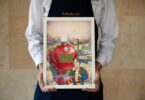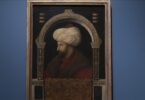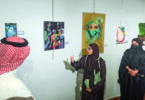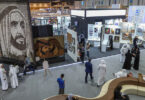Razmig Bedirian
In one of the opening works of Mosquito Effects, Iraqi-Canadian artist Mahmoud Obaidi’s solo exhibition at Meem Gallery, black splotches, streaks and ink-soaked pieces of thread line the canvas in what seems to be haphazard abstraction.
Up close, the ink is dizzying. Violent, even. A broad-stroked madness that criss-crosses with no ostensible reason.
Stepping back, however, reveals a little more. There is an outline of a skirt, with interesting patterns going down its length. The threads sewn into the work dangle from it to the floor, evoking something tattered and tragic.
The work is based on what is known as the Trail of Tears, the forced displacement of Native American tribes by the US government between 1830 and 1850. About 60,000 people from the Cherokee, Muscogee (Creek), Seminole, Chickasaw and Choctaw nations were displaced, many dying from exposure, disease and starvation while travelling to their government-designated reserve.
“When the US government forcibly removed them from their homes, they gave them directions,” Obaidi tells The National. “So, they walked, following the map they had been given, and they encountered mountains and valleys that weren’t on the map. They got lost. Children died, the elderly died. They died from hunger.”
Scroll through the gallery below for more images from Mahmoud Obaidi’s Mosquito Effects
:quality(70):focal(2209x1700:2219x1710)/cloudfront-eu-central-1.images.arcpublishing.com/thenational/KPYU77DKAZEWNF6OBRIIP77CZI.jpg)
:quality(70)/cloudfront-eu-central-1.images.arcpublishing.com/thenational/WTRDB4XULRAPJLVV4BU5YT7IVA.jpg)
:quality(70)/cloudfront-eu-central-1.images.arcpublishing.com/thenational/PDKWZMOBKRA5HCWIIV3GSAP4KE.jpg)
:quality(70)/cloudfront-eu-central-1.images.arcpublishing.com/thenational/ZEKJRZV62NADHID4F2LQCP3CSE.jpg)
:quality(70)/cloudfront-eu-central-1.images.arcpublishing.com/thenational/MLQ5R4XPR5C4RHO76YUIE4JCJA.jpg)
:quality(70)/cloudfront-eu-central-1.images.arcpublishing.com/thenational/AIFGL7NBYJBKBBRDNDX3TXTABA.jpg)
Iraqi-Canadian artist Mahmoud Obaidi’s Dubai exhibition Mosquito Effects looks at the brutality of colonialism. All Photos: Antonie Robertson / The National
Instead of simply painting the trail on canvas from a map, Obaidi decided to use thread, which is sewn in jagged patterns to reflect the deadly, meandering route taken by the Native Americans as they hoped to reach safety.
“These threads that go down to the floor is because there was no end to the map they were given,” Obaidi says.
Indigenous loss and the brutality of colonisation is the main focus of Mosquito Effects.
The title of the exhibition conjures something unsettling. Presumably inspired by the butterfly effect, or the theory that something as small and insignificant as the flap of a butterfly’s wing can have a great impact, it brings to mind those far-reaching repercussions but with the blood-sucking, disease-borne symbolism of the mosquito.
“I’m trying to show an ideology that I call the Mosquito Effect,” Obaidi says. “This ideology of killing and taking and corporate interest. I didn’t find any better metaphor. You see, I hate mosquitoes. You don’t see them until they bite you. It’s just like the destruction and killings. We don’t know who they are, but they plan things and things happen. And only after years, we begin to understand the people behind the atrocities and their motives.”
:quality(70)/cloudfront-eu-central-1.images.arcpublishing.com/thenational/5EWPZLSMGBD7FLSFWMWUJ47WBE.jpg)
The human capacity for violence is not something that’s lost on Obaidi. Born in Baghdad in 1966, he began pursuing art at the encouragement of his mother, a writer. He received a BA in fine art from the Academy of Fine Arts in Baghdad in 1990. That same year, he had his first solo exhibition, Cat’s Factory, at the Museum of Modern Art, which was then called the Saddam Arts Centre. By then, Iraq had already been feeling the impact of war with Iran, and had just invaded Kuwait, resulting in the Gulf War and ensuing economic sanctions.
“During the 1980s, all of our generation was so surrounded by destruction that we could not help but make art. While many of my friends chose to write, I chose to paint,” Obaidi is quoted as saying in the exhibition’s introduction.
“Generally speaking, my work is political,” he tells The National. “I don’t know why, maybe it’s because I’m from Iraq. Cat’s Factory was very political. We were going through a series of wars, and the state of the country was very politicised. You felt like you were being watched at all times.”
The sanctions imposed on Iraq made it increasingly difficult to acquire everyday supplies, including art materials. It also isolated the country’s citizens, limiting their exposure to the outside world.
Obaidi left the country in 1991, travelling to Jordan, Egypt, Tunisia, Thailand and China. He sought the stability and peace he needed to work, but instead felt the cold and loneliness of exile, stripped from a home, which he could see from a distance was deteriorating.
He finally settled in Canada, continuing his education and reprising his practice.
:quality(70)/cloudfront-eu-central-1.images.arcpublishing.com/thenational/PDKWZMOBKRA5HCWIIV3GSAP4KE.jpg)
With Mosquito Effects, Obaidi was inspired by a papier-mache toy he came across in an antique market in Venice in 2016. The figure depicted a Native American man fighting a white man with details that imposed the problematic dichotomy of civilised versus savage or good versus bad.
“I love to go to antique markets because it often gives me some idea for an artwork,” he says. “The papier-mache was 100 years old. I passed by it at first before going back.
“I remembered when we were children the bad guy was the Native American, and the good guy was white. Why? That was the media. The films, the TV shows, they propped up this narrative.”
As he began researching more about massacres and genocides, Obaidi surmised three tactics that he saw were often used when committing these atrocities.
“The first part of the research looked at the classical massacre, which is when you kill people and take the land. The second was what happened in Palestine, kick them out and take the land. The third part was Iraq — make chaos and people will leave. You don’t need to kill anyone. They killed, of course, but the chaos also drove five million people away from Iraq.”
Obaidi experimented with videos and installations, but ultimately found that painting was the best way to express his ideas. The large-scale paintings in Mosquito Effects not only offer insight into dark and obscured pockets of history, they incorporate impressions of maps and landscapes, abstracted topography and even the odd corporate logo, denoting the role of capitalism in perpetuating human loss.
Obaidi says what happened to Native Americans is not so far removed from what certain populations in the Middle East are experiencing today.
“It’s basically what happened to us, too,” he says.
Courtesy: thenationalnews







